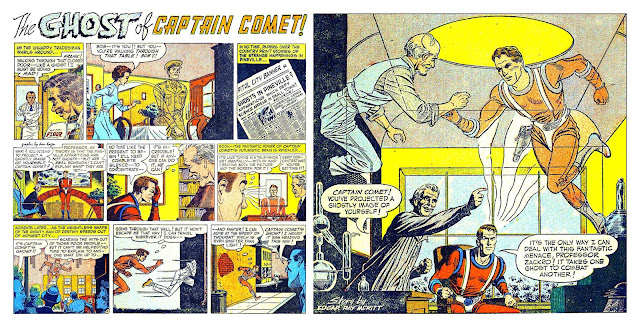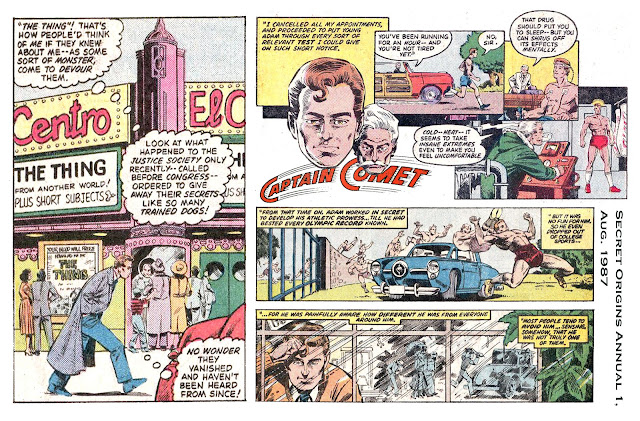January 1952: The Ghost Who Wasn’t Dead
Strange Adventures 16 (Jan. 1952) anticipates Dr. Strange with the
story The Ghost of Captain Comet.
When the Midwestern town of
Pineville panics after dead people begin to reappear there, the skeptical
Captain Comet decides to send his own “ghost” to investigate.
This new power of creating a
mental image of himself would be duplicated later in Stephen Strange’s astral
projections.
Comet learns that all the “ghosts”
are really an alien energy creature trapped here by an H-bomb test, and forced
into the shape of various dead people by the telepathic longings of those who
miss them.
The superhero is able to return
the frightened being to his real form – a puff of smoke — and his home
dimension.
This Captain Comet story
anticipated the brilliant Quatermass and
the Pit, a BBC science-fiction serial transmitted live in December 1958 and
January 1959.
The third and last of Nigel Kneale’s
Quatermass serials began with the appearance of “ghosts” and other spooky
phenomena in Hob’s Lane, a London street long said to be haunted. In fact, the
effects are caused by the telepathic transmissions of a buried
five-million-year-old Martian space ship that is about to be unearthed by excavations.
The protagonist, Prof. Bernard
Quatermass, is a clear successor to Conan Doyle’s Prof. Edward Challenger and
an ancestor of Dr. Who. Hammer Film made
an excellent movie of the story in 1967 as Five
Million Years to Earth.
Intellectual, analytical, ethical,
humane, open-minded but dismissive of superstitious bunk and irrational
twaddle, cool even in a vast crisis, the 1950s BBC hero Quatermass is the polar
opposite of the assorted assassins and prostitutes that contemporary popular
culture often offers as role models.
The U.S. had ended World War II by
developing and detonating the most fearsome technology ever known to humanity,
and American respect for science and technology was high when DC’s science
fiction comics were being published in the 1950s. So rationalism ruled, despite
the inherent absurdity of the subject matter.
Superstition was routinely
derided, and any apparent incursion by the supernatural forces like “ghosts”
was explained away by story’s end. DC Comics anticipated Scooby-Doo on that score.





Nicholas Burns wrote:
ReplyDeleteBelief in 'out of body experience' is part of many forms of philosophical and religious thought around the world --including Judeo-Christian faiths. In the late 1800s, 'astral projection' was popularized in the USA by the Theosophical Society which still exists today. Such preexisting beliefs, and the wide publicity they received, made the 'ectoplasmic self' an easily understood and accepted visual and conceptual device in comics -- one both esoterically cool, visually interesting, and useful. 🤓
Paul Zuckerman wrote:
ReplyDeleteBroome almost always went with a scientific explanation. He didn't seem to go for magic as someone like Gardner Fox might. When Broome created a magician, it was through future science (Abra Kadabra). So, this story is right in tune with that. There is only one story I can think of off-hand in which he allowed for something perhaps not scientific -- the Flash story Doorway to the Unknown in which Flash is visited by a spectral vision of someone he discovers had just died. Well, perhaps one other story -- the Secret Origin of the Guardians, in which a hand is seen at the creation of the universe. Spiritual, not spirits.
ReplyDeleteDaniel Bonner wrote:
Excellently informative commentary. Thanks.
Paul Hylemon wrote:
ReplyDeleteHow criminally underrated is Murphy Anderson!?
Andrew Macaluso wrote:
ReplyDeleteDan Hagen, the Captain was like the symbol of his age. Pre- Pure Silver Age Goodness and SCIENCE!